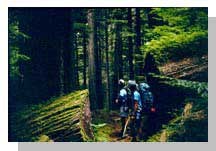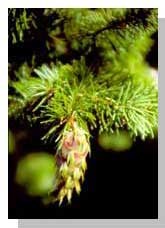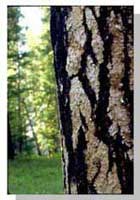|
Hiking trails wind through most of the major river valleys. Travel off-trail is difficult at best and nearly impossible in many places. River valleys are nearly impenetrable jungles of vegetation. Creeks and streambank habitats are choked with armies of inhospitable brush, including spiny devil's club, prickly currant, salmonberry, thimbleberry and willow. There are tales of mountaineers who spent days trying to bushwhack cross-country out of the Picket Range - crawling through brush that yielded less than a mile's passage for each day's effort.

The greatest concentration of old-growth western red cedar in the North Cascades is found along the lower reaches of Big Beaver Creek below 2,000 feet. Western red cedars are a long-lived species; the oldest are estimated to be over 1,000 years old. Red cedars grow in moist habitats. Thus, they are ideally suited to the North Cascades, where summers are cloudy and winters are mild. Tapering from heavily buttressed bases often over 10 feet in diameter, they rise 200 feet above the forest floor, balanced on a shallow, wide-spreading root system that provides stability in the wet valley soils. They are distinguished by their stringy, fibrous bark, which peels away in thin strips. Lacy sprays of flat needles give western red cedars a delicate appearance despite their great size. Native peoples living on the west side of the Cascades and along the coast used all parts of the "tree of life," making clothing and blankets with the inner bark and totems, dugouts, cooking utensils and lodging with the wood.

Another dominant tree of the river valleys is western hemlock. Both western red cedar and western hemlock are shade-tolerant; their seedlings thrive in the dense shade of lowland forests. Western hemlocks in an undisturbed area eventually out compete less shade tolerant trees like Douglas-fir to form the climax community of the low-elevation forests of the North Cascades. Growing in scattered, open glades throughout the hemlock forest are red alder and bigleaf maple. These two deciduous trees must have some scattered sunlight for their seedlings to grow. They appear along trails and streams and in openings created when a forest giant falls during a windstorm. Red alder is an important pioneer species that adds nitrogen to the soil through nodules of symbiotic bacteria (mycorrhizae) on its roots. Bigleaf maple is easy to identify with its giant five-lobed leaves spanning 16 inches or more. When walking along a forest trail, occasionally climbing over fallen trees and ducking under low-hanging branches, we see a spectrum of the many shades of green. Huckleberries tantalize the hiker along the trail. In drier locations, salal and Oregon grape, both evergreen shrubs, dominate the understory, while sword fern and its many relatives grow throughout the forest. In springtime the forest floor is thick with wildflowers. Trillium, bleedingheart, yellow violet, calypso orchid, twinflower and arrow-leaf balsam root display their delicate colors and brighten the forest shade. Mosses, lichens and fungi grow thickly over and under the ground and on exposed rocks and fallen trees. 
Only gradual changes in the physical environment and in the plant and animal communities distinguish river valleys from mountain forests. A slight chill in the air is felt that brings an awareness of snowy peaks rising from these mountain forests. As we climb, the land becomes drier and more open. The red cedars give way to a mixture of western hemlock and Pacific silver fir. Red alder, Douglas-fir and Bigleaf maple still grow in sunlit openings. Every now and then, a trail crosses an open slope, a remnant of avalanches that thunder down from surrounding peaks every winter. Vine maple and many other shrubs compete vigorously for space and light on these avalanche paths. At about 4,500 feet elevation mountain hemlock replaces western hemlock in the forest canopy, in a silver fir forest. On the drier east side of the North Cascades, a similar change is taking place, although different tree species are involved. Douglas-fir and ponderosa pine grow at lower elevations. At higher altitudes western larch, lodgepole pine and Engelmann spruce replace them. Western hemlock and western red cedar are not as common. Black cottonwood and willow line the rivers. With open landscapes and a relative absence of brush, the east side of the North Cascades invites the cross-country explorer. |
Last updated: August 11, 2017
